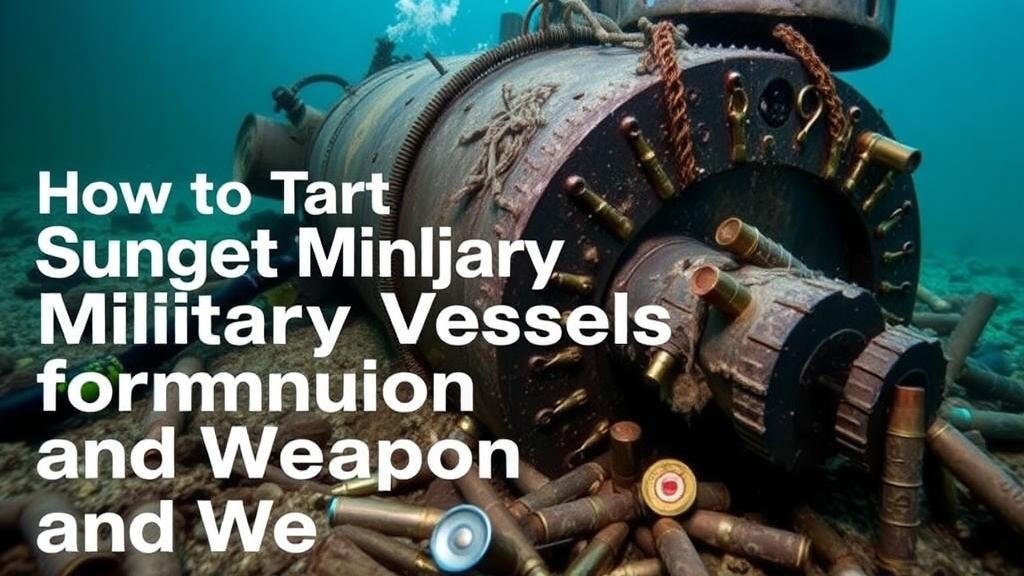How to Target Sunken Military Vessels for Ammunition and Weapon Relics
How to Target Sunken Military Vessels for Ammunition and Weapon Relics
The hunt for sunken military vessels is a pursuit that combines historical research, advanced technology, and a deep appreciation for maritime archaeology. These vessels, often laden with ammunition and weaponry, provide a unique glimpse into the military strategies and technologies of past wars. This article covers essential strategies and methodologies for targeting such wrecks, including legal considerations, technological approaches, and historical context.
Understanding the Historical Context
Before embarking on a search for sunken military vessels, one must understand their historical significance. Ships lost in battle are often emblematic of pivotal moments in naval history. For example, the USS Arizona, a battleship sunk during the attack on Pearl Harbor, serves as a memorial site and is protected under the National Historic Landmark program. Understanding these historical narratives can not only shape the search approach but also inform legal permissions required for retrieval operations.
Legal Considerations
Diving into the wrecks of sunken military vessels necessitates a thorough understanding of international maritime law and national regulations governing maritime archaeology. Some key legal frameworks include:
- United Nations Convention on the Law of the Sea (UNCLOS): This treaty outlines the rights and responsibilities of nations concerning their use of oceans, including the conservation of underwater heritage.
- National Historic Preservation Act (NHPA): In the United States, this act protects historically significant sites and requires federal agencies to consider the effects of their undertakings on such sites.
- Protection of Military Remains Act (2003): This UK law prohibits unauthorized excavation or alteration of military remains, emphasizing respect for the site as a war grave.
Engaging with local and national authorities to obtain necessary permits is imperative before beginning any recovery efforts.
Technological Approaches
Modern technology plays a crucial role in locating and examining sunken military vessels. Here are some of the methods currently utilized:
- Side-Scan Sonar: This technology provides detailed images of the seafloor and submerged objects, making it possible to spot sunken vessels from significant distances.
- Submersibles and ROVs: Remotely operated vehicles (ROVs) equipped with cameras and manipulative arms allow for in-depth exploration of wreck sites without endangering divers.
- Metal Detectors: These devices can be employed during diving expeditions to locate weaponry or ammunition within wrecks.
For example, the exploration of the wreck of the German U-boat U-869 off the coast of New Jersey utilized ROV technology to document its condition and locate artifacts, highlighting how technological advancements have revolutionized underwater archaeology.
Targeting Specific Wrecks
Identifying which wrecks to target involves a combination of research and technology. Potential strategies include:
- Historical Research: Archival research in military records and naval logs can reveal the last known positions of vessels before they sank. Libraries and historical societies may provide maps and salvage reports.
- Crowdsourced Data: Engaging with diving communities and historians can yield information about lesser-known wrecks that may not be documented in formal archives.
- Marine Surveys: Conducting underwater surveys in suspected areas can provide real-time data on the presence of wrecks.
For example, during operations linked to World War II, systematic surveys have led to the discovery of numerous wrecks in the Pacific Theater, each harboring potentially valuable artifacts and ammunition.
Preservation and Ethical Considerations
It is critical to approach the recovery of artifacts from sunken military vessels with a preservationist mindset. Unearthing items from these sites poses risks both to the artifacts and the historical context. The following guidelines should be adhered to:
- Document Everything: Maintain detailed records of any items recovered, including their condition and context at the site.
- Follow Conservation Practices: Engage specialists in artifact conservation to ensure that retrieved items are preserved effectively for future generations.
- Engage with Local Communities: Involve indigenous and local historical narratives in the process to promote cultural respect and understanding.
Actionable Takeaways
The endeavor to locate and recover ammunition and weapon relics from sunken military vessels is both challenging and rewarding. Key takeaways include:
- Research the historical significance of targeted vessels thoroughly.
- Understand and comply with all legal regulations relevant to maritime salvaging.
- Use advanced technologies like side-scan sonar and ROVs for efficient searching.
- Maintain ethical standards by preserving artifacts and respecting the historic sites.
By integrating these approaches, individuals and organizations can contribute to the preservation of naval history while responsibly exploring the rich narratives tied to sunken military vessels.



